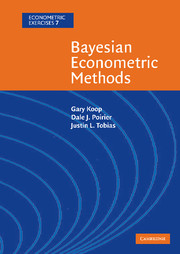Book contents
- Frontmatter
- Contents
- List of exercises
- Preface to the series
- Preface
- 1 The subjective interpretation of probability
- 2 Bayesian inference
- 3 Point estimation
- 4 Frequentist properties of Bayesian estimators
- 5 Interval estimation
- 6 Hypothesis testing
- 7 Prediction
- 8 Choice of prior
- 9 Asymptotic Bayes
- 10 The linear regression model
- 11 Basics of Bayesian computation
- 12 Hierarchical models
- 13 The linear regression model with general covariance matrix
- 14 Latent variable models
- 15 Mixture models
- 16 Bayesian model averaging and selection
- 17 Some stationary time series models
- 18 Some nonstationary time series models
- Appendix
- Bibliography
- Index
9 - Asymptotic Bayes
Published online by Cambridge University Press: 05 June 2012
- Frontmatter
- Contents
- List of exercises
- Preface to the series
- Preface
- 1 The subjective interpretation of probability
- 2 Bayesian inference
- 3 Point estimation
- 4 Frequentist properties of Bayesian estimators
- 5 Interval estimation
- 6 Hypothesis testing
- 7 Prediction
- 8 Choice of prior
- 9 Asymptotic Bayes
- 10 The linear regression model
- 11 Basics of Bayesian computation
- 12 Hierarchical models
- 13 The linear regression model with general covariance matrix
- 14 Latent variable models
- 15 Mixture models
- 16 Bayesian model averaging and selection
- 17 Some stationary time series models
- 18 Some nonstationary time series models
- Appendix
- Bibliography
- Index
Summary
As seen in previous chapters, the Bayesian approach typically involves the evaluation of multidimensional integrals such as those appearing in posterior expectations, marginal likelihoods, and predictive densities. In nonconjugate situations, these integrals cannot be calculated analytically. In future chapters we present questions relating to various methods for evaluating such integrals using posterior simulation. However, posterior simulation can be computationally demanding and, hence, Bayesians sometimes use asymptotic approximations. Such approximations are the focus of this chapter.
In most situations the prior p.d.f. does not depend on sample size T, and so in large samples, the likelihood eventually dominates the prior density over their common support. This suggests that consideration of the behavior of the posterior density as T → ∞ may provide useful analytical approximations when T is in fact large. Such “Bayesian asymptotics” differ, however, from frequentist asymptotics in an important way. The thing being approximated in Bayesian asymptotics is conceptually well defined in finite samples, namely the posterior p.d.f. Nuisance parameters can be addressed in a straightforward manner by marginalizing them out of the posterior to obtain the exact marginal posterior p.d.f. for the parameters of interest. In general, there is no frequentist classical sampling distribution of estimators in finite samples that is free of nuisance parameters.
In the same way that sampling distributions of maximum likelihood estimators (MLEs) in regular situations are asymptotically normal, posterior densities are also approximately normal. This result is stated informally in the following theorem.
- Type
- Chapter
- Information
- Bayesian Econometric Methods , pp. 91 - 106Publisher: Cambridge University PressPrint publication year: 2007



